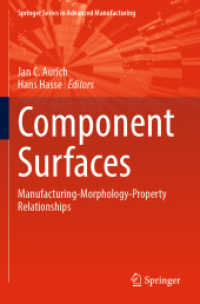Full Description
This book constitutes the refereed proceedings of two long-running events held along with the CAiSE conference and related to the areas of enterprise, business-process and information systems modeling:
- the 26th International Conference on Business Process Modeling, Development and Support, BPMDS 2025 and
- the 30th International Conference on Exploring Modeling Methods for Systems Analysis and Development, EMMSAD 2025.
The conferences were taking place in Vienna, Austria, during June 16-17, 2025.
For BPMDS 12 full papers were carefully reviewed and selected for publication from a total of 39 submissions. The BPMDS papers deal with a broad range of theoretical and applications-based research in business process modeling, development and support.
For EMMSAD 13 full papers and 3 short papers were accepted from a total of 37 submissions after thorough reviews. EMMSAD focusses on modeling methods for systems analysis and development.
Contents
.- Business Process Improvement.
.- AI-Enhanced Business Process Automation: A Case Study in the Insurance Domain Using Object-Centric Process Mining.
.- Identifying Process Improvement Opportunities through Process Execution Benchmarking.
.- Interdependency-Aware Business Process Prioritization for Process Improvements.
.- Human-AI Interplay in Exploring Process Representations.
.- Human-AI Collaboration for Business Process Modeling with Petri Nets.
.- Repairing Process Descriptions by Discovering Deviations from Process Models.
.- Process Model Complexity Metrics, Cognitive Load and Visual Behavior: A Multi-Granular Eye-Tracking Analysis.
.- Event Data Extraction.
.- Which Tables are Mine(able)?.
.- OCPM2: Extending the Process Mining Methodology for Object-Centric Event Data Extraction.
.- Making the Case for Process Analytics: A Use Case in Court Proceedings.
.- Probabilistic Approaches to Uncertainty and Prediction in Process Mining.
.- Predicting Unseen Process Behavior Based on Log Injection.
.- Toward IoT-based Process Analytics: Extending Event Knowledge Graphs with Ambiguity.
.- Probabilistic Learning of Temporal Uncertainties in Business Processes.
.- AI-Driven Modeling and Analysis.
.- Assessing the Suitability of Large Language Models in Generating UML Class Diagrams as Conceptual Models.
.- Exploring the Influence of Data Characteristics on Machine Learning Outcomes.
.- Can an LLM Use Work System Axioms when Describing Work Systems for Requirements Analysis?.
.- Security.
.- Forensic Readiness and Privacy: Towards Resolving Software Goal Conflict.
.- An ontological model of the phishing attack process.
.- harborLang: Enhancing Maritime Operational Safety Through Cyber Threat Simulation and Assessment.
.- Evaluation of Modeling Practices.
.- Learning Analytics Dashboard with Peer Comparison for Student Feedback in Conceptual Modeling Education.
.- Are Code and Design Models Similarly Effective in Understanding Software Structure and Behavior?.
.- Towards a Maturity Assessment Framework for MBSE Adoption: Results from a Meta-Synthesis.
.- Modeling of and within Organizations.
.- Enhancing C2-Systems: Validation of Goal and Concept Models with Stakeholders.
.- Supporting Collaborative Design by Diagram Briefs in the Early Stage of Innovation Projects.
.- A Metamodel for Applying Green BPM Approaches with the EU Taxonomy.
.- Experience Report: Applying a Capability Heat Map in a Government Organization.
.- Domain Modeling.
.- State of the Art and Research Directions for Visual Conceptual Modeling in Robotics.
.- A Domain-specific Modeling Method for Designing Conversational Agents for Coaching: A Case from Health Coaching.
.- Designing Decision Support Systems for Rural Mobility Enhancement.








